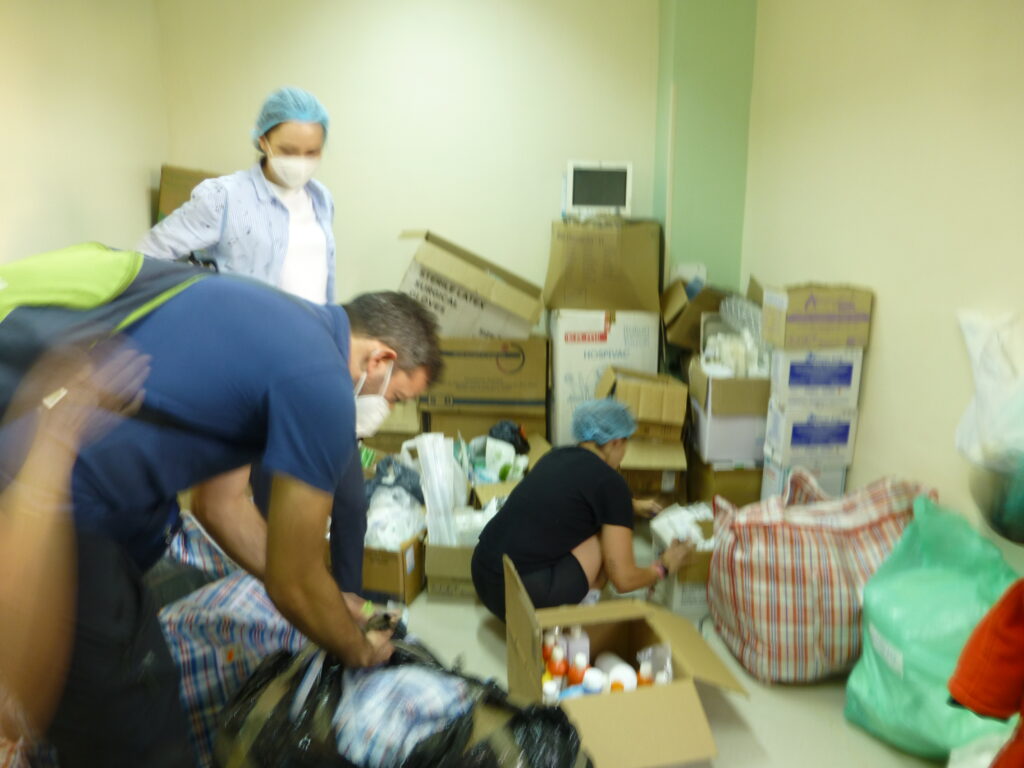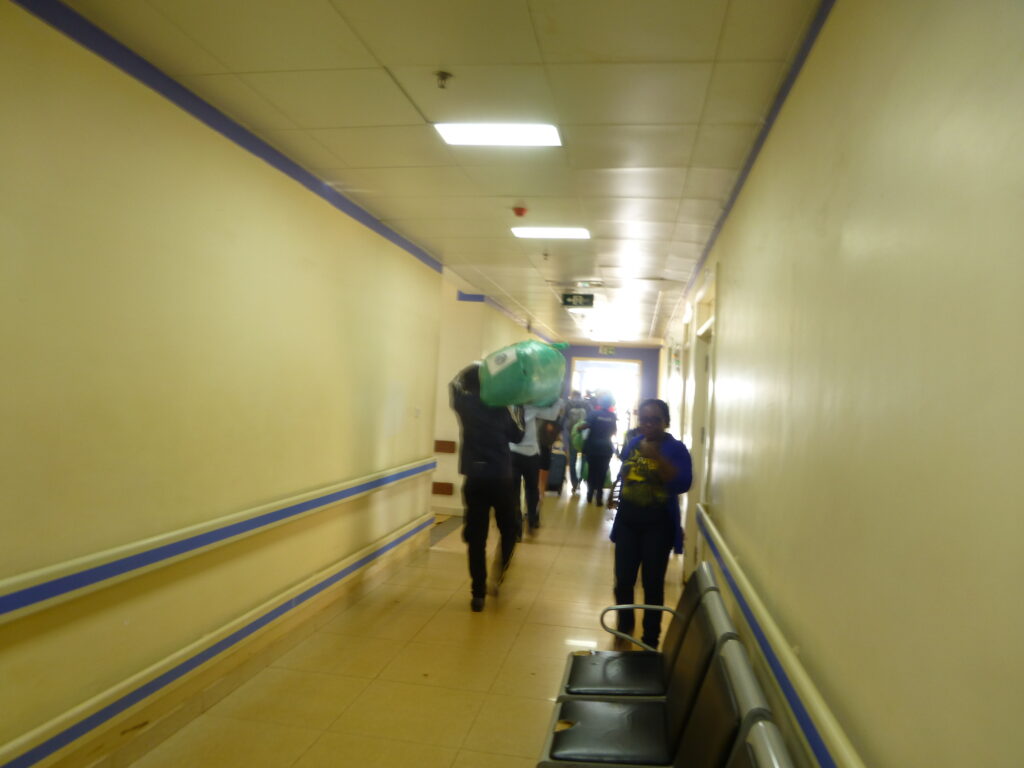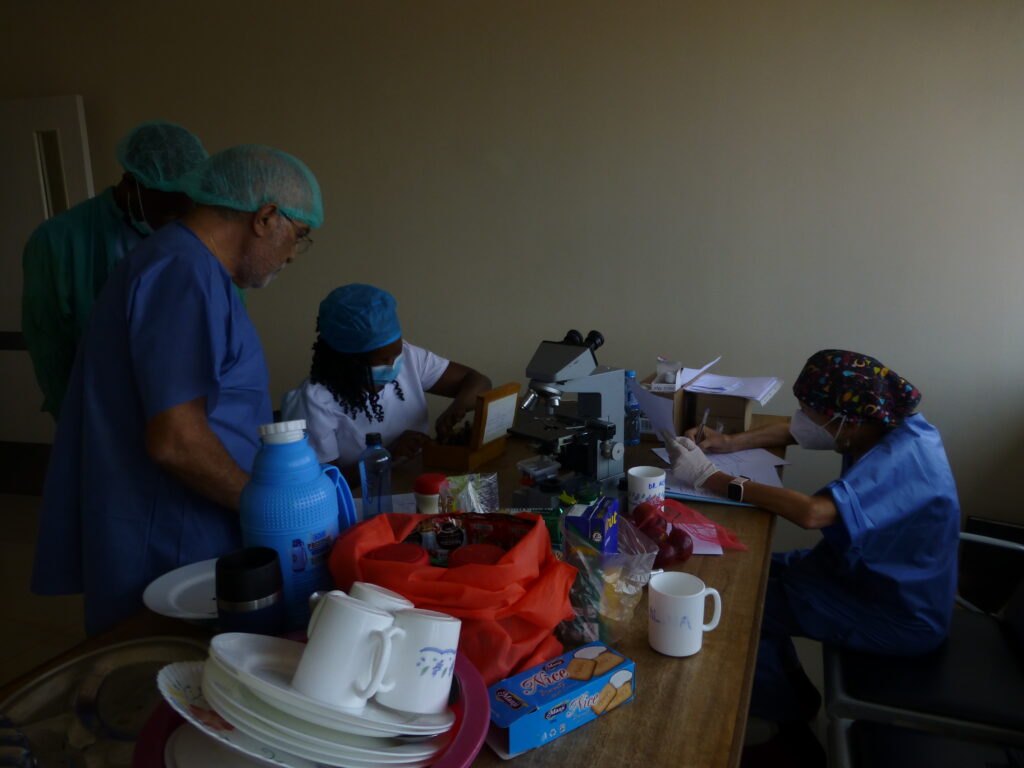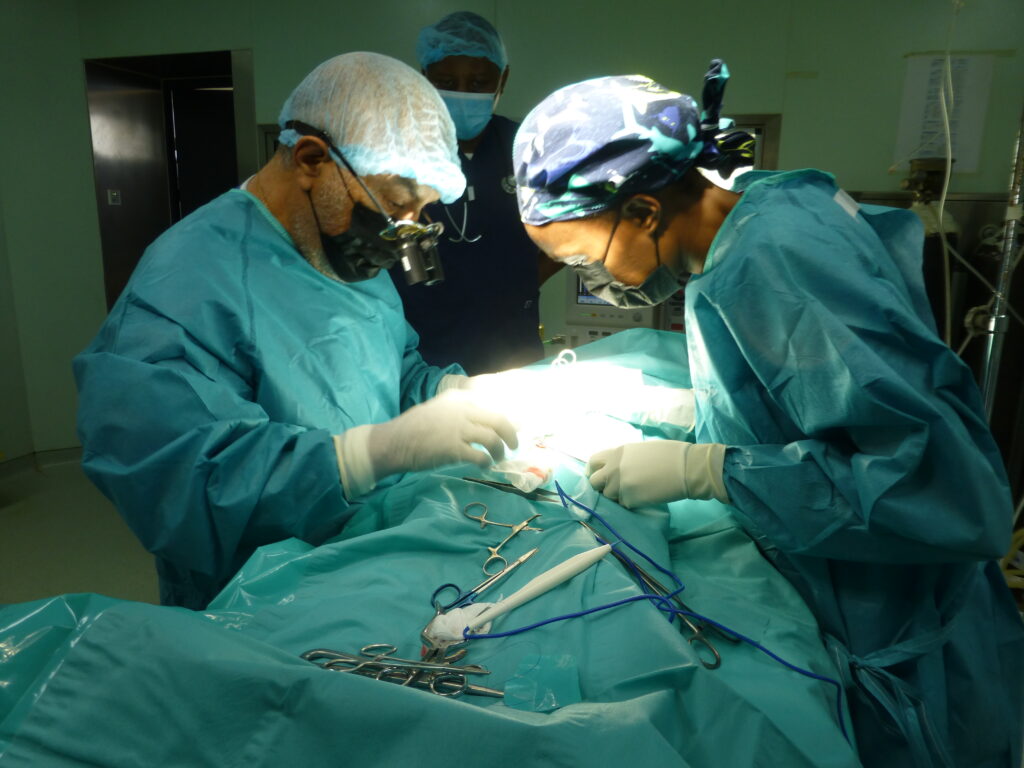REPORT: GATUNDU-KENYA CAMP 2022

1. TECHNICAL REPORT:
a. DATES AND LOGISTICS DEVELOPED: 25th November – 4th December.
It was carried out in collaboration with Hernia International Foundation, Prof. Andrew Kingsnorth made it possible for us to do it on very short notice.
It was prepared in a month and a half, made possible by the hospital director, Dr. Jesse Ngugi, who responded quickly to all questions and with the help of the secretary Lizz Beth, we submitted all the documentation to obtain the temporary permits (passports, diplomas, diplomas translated by a sworn translator, certificate of suitability and CV in English). She also helped us to book the hotel and the hospital provided an all-terrain vehicle with driver (Samuel Macharia) for transport from the airport and daily from the hotel to the hospital.
All volunteers collected consumables (surgical gowns, drapes and surgical fields, sutures, mesh, bladder catheters, sterile and operating gloves, anaesthetic material). The 12 de Octubre University Hospital donated anaesthetic medication worth around €500.
The air tickets were taken through Angelis (freelance of Halcon Viajes) with the company Egyptair, which allowed the transport of 2 bags of 23 kg per person + cabin baggage. We carried a total of 400 kg of material including 2 diathermy generators.

b. ADULT PATIENTS:
H- supraumbilical+ epigastric +diastasis rectus : 8. ( fascia plication, reinforced suture, prefascial mesh).
H umbilical: 3
H epigastric / supraumbilical. 4
H. inguinal 13, 4 bilateral (T. Lichtenstein, T Wantz (1)
Incisional H 4 (T. Rives Stoppa, T Stoppa)
Lipomas 3
Sebaceous cyst 1
Hydroceles 4
c. PAEDIATRIC PATIENTS:
Undescended testicles: 30
Inguinal hernia 8
Umbilical hernia 6
Hydrocele: 2
Phimosis 1
Total procedures: 87
Total patients 84 patients (47 boys)
d. COMPLICATIONS: We had no complications during our stay and in the follow-up done by Dr. Chacha.
2. CAMPAIGN REPORT
a. THE PLACE
Kenya, located in East Africa, has a population of 51,393,010 people. Its capital Nairobi has a population of 3,130,000 and its currency is the Kenyan shilling (1 KES = 0.01 Euro). It is a multi-party republic. The majority of the population is Christian, with 35% Protestant and 30% Catholic, 30% Muslim and 5% Animist, and the official languages are Swahili and English as well as numerous tribal languages.
Kenya’s GDP per capita, an indicator of its standard of living, was €1,449 (Spain $28,156), and it ranks 152nd out of 192 countries, and the Human Development Index or HDI, which measures a country’s progress and the standard of living of its people, ranks 142nd, indicating that its people have a very low standard of living.
Gatundu is a small town of about 20,000 people located in Kiambu County with a population of 1,600,000 and is situated about an hour’s drive from Nairobi. It is the birthplace of Kenya’s first president, Jomo Kenyatta, who has a luxurious hilltop residence overlooking Gatundu. In contrast, the town’s infrastructure is very poor, with most of the houses and shops located on both sides of the main road; The shops are distinguished by signs hanging over their doors advertising their businesses, there are numerous fruit and vegetable stalls, churches and schools of different orders and faiths, and on the unpaved side streets, the doors of the houses remain open. The population lives on a dollar a day. Rice, vegetables and other farm produce are the staple food.
The V Level Gatundu Hospital is a hospital funded and built in 2013 by China at a cost of 11 million dollars and was inaugurated in 2016. Another wing is currently under construction and will be used for oncology. It is an annex to the old Gatundu Hospital, consisting of several single-storey pavilions connected to each other, with large green areas.

It has 5 floors; on the ground floor there are emergency, admission and outpatient services, two hospitalisation floors with several wards with eight beds each, where the operated patients were accommodated. A gynaecology and obstetrics area on the first floor and on the third floor the surgical area with two operating theatres called “Theatres 3 & 4”, which are underutilised, and in which we carry out our operations. On the 3rd day, another operating table was installed in operating theatre 3, so that we had 2 tables for adults and one for children in the other operating theatre.
The operating theatres are spacious and relatively new, but lacking a lot of equipment; the lighting is good and stable, with no need to use the headlights. There are two well-functioning ventilators and a Valleylab diathermy generator in Theatre 3, which works well; in Theatre 4 we installed an diathermy generator console owned by our Foundation.

The AER room is very basic; this is where patients were monitored after surgery and watched over by a nurse from the Hospital.
There is a relaxation room for the staff, which we used as an office for writing reports, and also as a dining room, since we were served lunch here every day, which included stewed meat, rice, pinto beans and vegetables, as well as coffee and mineral water.

The surgical area also has a storeroom in which we stored all the material contributed to the campaign (face masks, ventimask, bladder and nasogastric tubes, disposable surgical drapes and gowns, new pyjamas, bandages, electric scalpels and plates, surgical gloves, masks, antiseptics for hand washing, meshesm sutures,etc.. We found numerous untidy boxes with material from previous campaigns such as sutures, dressings, general anaesthetics such as halothane, antibiotics, needles and abocaths, needles for spinal anaesthesia, endotracheal tubes, laryngeal masks, face masks, vents, skin staplers and staple removers, etc. To this material we must add the material left by our team at the end of the campaign. Dr Chacha, the current surgeon at the hospital, said he would organise all the material so that it could be used.

b. THE TEAM was composed of 10 volunteers
Team leader: Teresa Butrón
General surgeons: Teresa Butrón, J Ignacio Tello, S Fdez Arias.
Neurosurgeon: Alina Costache.
Paediatric surgeon Alejandro Unda.
Anaesthetists: Fernando Asensio, Adolfo Ramos Luengo.
Paediatric Intensivist: Emilia Tallo.
Nurses: Elvira Vallejo Sánchez. M J Fornier.
c. LOCAL STAFF:
Hospital surgeon: Dr. Clifford Chacha Mwite.
Other surgeons from nearby hospitals were on hand for the campaign:
General surgery: Dr Winfred Kimani.
Paediatric surgeons: Robert Mugo, Vivien Cheboiwo.
Anaesthesiologists from the hospital: Justus Murago, Ruth Muiruri, Eric Karuri, Isaac Karaba.
Nurses: Kennedy Weru, Ruth Waithaka, Lucia Nguru, Claire Njeri, David Chege, Marycyne Chesori.
We have also had medical and nursing students who have helped us, showing great interest in learning about our work.

d. EQUIPMENT: There is quite a lot of material in big boxes which we made sets for hernias, etc. to optimise it. Many Crile forceps are in poor condition. We used the consumables we brought with us although on the last 2 days we used sterile cloth gowns. The electric scalpel generator was useful as we were able to operate on 3 operating tables.
e. ANAESTHESIA: Adult patients were anaesthetised by the volunteer anaesthesiologists, mostly with regional anaesthesia, and in the case of incisional H., with general anaesthesia, always with the material and medication that we carry. Children were anaesthetised by local anaesthesiologists.
f. ASEPSIS AND SURGICAL MATERIALS: Sterilisation was carried out with a heat-operated autoclave.
g. OUR DAILY LIFE: We left Madrid airport on Friday 25th November with the Egyptair airline with a stopover in Cairo, which was delayed and this meant that in Cairo we had to rush to catch the flight to Nairobi. We arrived at 3:00 on the 26th and 5 packages of material were lost in Cairo, including a generator and another with medication. Thanks to the efforts of Dr. Chacha and Dr. Ngugi, they arrived at the hospital on the third day. At the airport we exchanged money, which was absolutely necessary to have the local currency, the Kenyan shilling, to pay for small items such as drinks, food, souvenirs, etc. We passed through customs without any problems on presentation of the letter from the campaign. We were picked up by Samuel and transferred to the Maxland Hotel https://maxlandhotel.co.ke/ which is half an hour’s drive from Nairobi and about 20 minutes from Gatundu Hospital. It is very secure as it is within a fenced compound with access controlled by security guards. The rooms are single, with en-suite bathrooms and beds with mosquito nets, and are very clean and hygienic. It has wifi which works very well both in the rooms and in the common areas (hall and dining room). Breakfast is buffet style. There is a shopping centre next to the hotel with small shops, a pizzeria and a supermarket where you can buy everything you need. The price of the hotel including breakfast and dinner was about 40 dollars a day. At midday we went to the hospital and were welcomed by the nurse in charge of sterilisation; we visited the different parts of the surgical area and the nurses cleaned, ordered and classified the medical-surgical material as well as organising and equipping the two operating theatres, the rest we went with Dr. Chacha to see the patients ready to operate on Sunday. From Sunday 27th to Friday 2nd we carried out 6 surgery sessions from 8h -19h or some days later, in addition we visited the operated patients in the morning and in the afternoon we saw the patients who would be operated on the following day. We were always accompanied by Dr. Chacha who assisted in several operations and sometimes we helped him, as did Dr. Kimani; Dr. Unda was also assisted by the paediatric surgeons who came for the campaign. Dr Tallo (paediatric intensivist) made it possible for many children to be operated on because she supported Dr Unda, the paediatric surgeon, by seeing the children, following the postoperative period and writing in the medical records. On Friday afternoon we finished early and packed up the generators, took photos with all the staff and said goodbye, the hospital director, Dr. Jesse Ngugi told us that for the next campaign more patients would be recruited, after the pandemic and with only 1.5 months notice, it had been complex.
On Saturday 3rd, 5 volunteers left for the Masai Mara Park to return to Madrid on the 6th of December, the rest of us went to Nairobi National Park where we saw rhinos, giraffes, etc. We returned on Sunday 4th December at 4:00 from Jomo Kenyatta Intl airport in Nairobi, to Madrid, we lost 4 bags, with the generators that were recovered a week later.
It has been a good campaign because we have worked as a team with the local staff and exchanged knowledge – both parties were satisfied.

3. CONCLUSION
Strengths of this place: It has 2 operating theatres, one of which can be fitted with 2 surgical tables, has a respirator and there are staff, a surgeon in the hospital who recruits patients and is interested in sharing knowledge. The director is interested in the continuation of the campaigns and is efficient and quick to respond. In addition there are anaesthesiologists who put children to sleep.
Objectives for improvement: Greater recruitment of patients. To be able to see them in the consulting room without them being admitted beforehand. Increase the number of patients undergoing outpatient surgery. To make a kit of instruments for hernias.
4. BUDGET:
COST PER PARTICIPANT: air ticket 857 €, hotel (bed + half board) 40 $ / day x 8 days = 320 $, Visa: 60 €. Total per person: 1.237 €.
TOTAL COST OF THE CAMPAIGN: 11.800 €.

